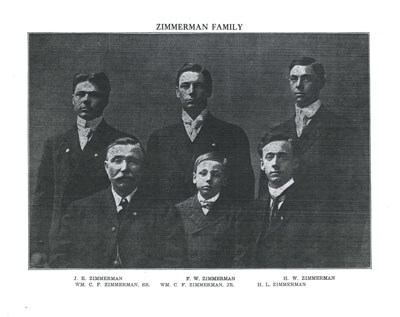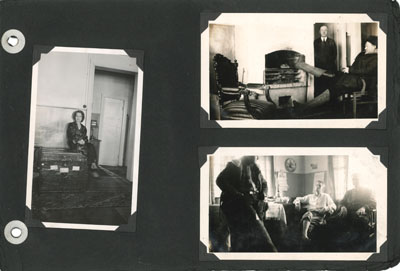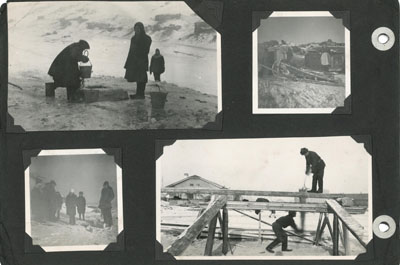How did a man from Iowa help launch the Soviet steel industry? What was it like for American engineers to work side by side with Russian workers in the 1930s? Who did Soviet leader Nikita Khrushchev greet as an old friend when he visited Iowa in 1959? Read on to find out the answers.
In 1931, Henry Zimmerman of Lone Tree, Iowa traveled to Kuznetsk, Siberia, to oversee the building of steel mills in the Soviet Union. The University of Iowa Special Collections has been collaborating with Russian History doctoral student Irina Rezhapova (Kuzbass Institute of the Federal Penal Service) on a special digital project which tells the story of Zimmerman’s journey. Special Collections will be making available online Henry Zimmerman’s personal letters and scrapbooks of photographs, news clippings and ephemera about his time in Soviet Siberia – all part of our Records of the Zimmerman Steel Company (http://www.lib.uiowa.edu/spec-coll/MSC/ToMsC900/MsC850/zimmermansteelworks.html).
This is ENTRY 1 of 3 of the Zimmerman Steel Journey.
Who was Henry L. Zimmerman, the Steel Maker of Iowa?
Photograph of the men of the Zimmerman family, 1910s. Henry Zimmerman is bottom right.
Born in Davenport in 1879, Henry L. Zimmerman took an early interest in the family foundry business run by his father, and by the mid-1910s he helped expand the Lone Tree and Bettendorf-based Zimmerman Steel Company into electrification, waterworks, and steel works, exporting steel products as far as Russia, Japan and Australia.
“A Personal Word from the Father of the Zimmerman Family.” Advertising brochure of the Zimmerman Steel Company, 1910s.
In 1929 The Santa Fe Railway hired Henry Zimmerman as foundry engineer, in which capacity he traveled from the Mississippi to the Eastern Seaboard, inspecting the company’s plants, taking care of problems and working to make the plants more efficient and productive. This experience may have been the reason why the Freyn Engineering Company soon selected Henry Zimmerman as their chief foundry engineer, one of fifty-seven specialists chosen to establish modern steel mills in Soviet Russia. For people like Henry Zimmerman, a trip to the Soviet Union probably also held the promise of international professional experience, as well as an exotic adventure.
What were the living and working conditions in Siberia like?
Pictures from Henry Zimmerman’s Siberian photo album
When Henry L. Zimmerman arrived at Kuznetsk, Siberia on January 7, 1931, the local temperature was so cold that the heating plants and water mains buried under ground froze and burst. Zimmerman spent the first few weeks in a hotel where “we’d go to bed wearing our caps and mittens, everything but our boots.” (“Personality Profile: Ageless Wizard is still Going Strong,” by Jim Arpy, Sunday Times-Democrat July 26, 1964)
Once the Americans were scheduled to go to Kuznetsk to build the Kuznetsk Steel Mill, with Zimmerman among them, the Soviets began to build wooden houses for them, which may have been rather spacious. The “foreigners” had a special service – stores with a better variety of goods and somebody playing the role of servants who cleaned their rooms. Some of the apartments not occupied by the foreign specialists were used to accommodate some of the front-rank Soviet workers. According to Russian workers’ memoirs, each apartment served as a home for three people: one in the living room, another in the kitchen, and the third one sleeping in the bathroom. They were satisfied, because other workers lived in worse conditions. (From Irina Rezhapova)
The harsh winter weather of Siberia posed special challenges to those building the steel mills. In a letter of March 15, 1931, Zimmerman asked his son Jimmy to
“Try to picture, what a job it has been to dig all these […] deep pits for the foundation, thru two to three meters of frost when the thermometer was from -40° C to -60° C and the River frozen six feet deep. Frequently it would freeze 6″ to 10″ in a single night, even at the bottom of the pits if they were not covered. We had to plank each pit over and cover it with earth, put in a stove and keep a fire in each pit while the concrete was poured and set.”
How did Kuznetskostroy become a Soviet steel boom town?
“Twelve months ago this was a cold, barren, frozen waste, covered with snow and only the howl of the wolf was heard as he chased the Siberian rabbit. Now in dugouts, tents, loghouses and modern homes thirty thousand people live and all have all the work they can do and about 500 more come each week.” (Henry Zimmerman, letter of March 15, 1931)
Russian magazine article from the early 1930s about the building of the Kuznetsk steel mill
“To describe the work here would take too long except that we are building a group of factories and a city like Gary, Ind[iana] and including everything that is needed in such an industry. In the foundry, which will make iron, steel, brass, and aluminum […] This brick yard will be the most modern and most complete in the whole world, and will make common brick, pressed brick, fire brick, silica brick and fire clay suitable for each [.]” (Henry Zimmerman, letter of January 16, 1931)
Please check our blog for the second and third entry of the Zimmerman Steel Journey.
By Gyorgy “George” Toth, PhD Candidate in American Studies, Olson Fellow, The University of Iowa Special Collections & University Archives,
With
Irina Rezhapova, PhD Candidate, Russian History, Kuzbass Institute of the Federal Penal Service






